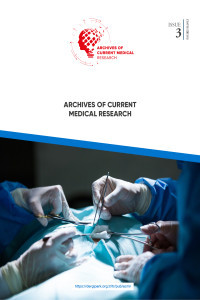Patients with third degree burns in an emergency department
Patients with third degree burns in an emergency department
Emergency department, Third Degree Burn, Epidemiology,
___
- 1. Özkaya NK, Alğan S, Akkaya H. Assessment and Defining the Treatment of the Patients with Burns. Ankara Med J. 2014;14(4):170-175.
- 2. Koltka K. Burn Injuries: Burn Depth, Physiopathology and Type of Burns. Journal of the Turkish Society of Intensive Care. 2011;9(Special Issue):1-6.
- 3. Peck MD. Epidemiology of burns throughout the world. Part I: distribution and risk factors. Burns. 2011; 37:1087–1100.
- 4. Smolle C, Cambiaso-Daniel J, Forbes AA, Wurzer P, Hundeshagen G, Branski LK et al. Recent trends in burn epidemiology worldwide: a systematic review. Burns. 2017; 43:249–257.
- 5. Organization WH. A WHO plan for burn prevention and care. Bull World Health Organ. 2008; 87:802-803.
- 6. Davé DR, Nagarjan N, Canner JK, Kushner AL, Stewart BT; SOSAS4 Research Group. Rethinking burns for low & middle-income countries: Differing patterns of burn epidemiology, care seeking behavior, and outcomes across four countries. Burns. 2018;44(5):1228-1234.
- 7. Yoshino Y, Ohtsuka M, Kawaguchi M, Sakai K, Hashimoto A, Hayashi M et al. The wound/burn guidelines-6: Guidelines for the management of burns. J Dermatol. 2016;43(9):989-1010.
- 8. Açıkel C, Peker F, Yüksel F, Ülkür E, Kale B. 734 Akut yanıklı sivil ve asker hastanın retrospektif analizi. Türk Plast Rekonstr Est Cer Derg. 2001;9(2):111-115.
- 9. Haik J, Liran A, Tessone A, Givon A, Orenstein A, Peleg K; et al. Burns in Israel: demographic, etiologic and clinical trends, 1997-2003. Isr Med Assoc J. 2007;9(9):659-62.
- 10. Demirel Y, Çöl C, Özen M. Evaluation of the Patients Treated in the Ankara Numune Hospital Burn Centre in One Year. C. Ü. Tıp Fakültesi Dergisi.2001;23(1):15–20.
- 11. Pal N, Jain U, Mishra V, Poonam, Jangra A. Analysis of incidence, etiology and risk factors associated in acute burns injury in adults. International Journal of Surgery Science. 2019;3(3):65-67.
- 12. İlhan E, Cengiz F, Demirkıran MA, Yılmaz S, Deneçli AG. Evaluation of our 15-month experience in the Izmir Bozyaka Education and Research Hospital Burn Unit. Ulusal Cerrahi Dergisi. 2011;27(3):154-158.
- 13. Achbouk A, Boufars A, Zrara A, Bouaiti E, Ribag Y, Siah S, Elkafssaoui S. Epidemiological Analysis of Burn Patients in Morocco: About 160 Cases. IOSR-JDMS. 2019;18(2):76-79.
- 14. Calder F. Four years of burn injuries in a Red Cross hospital in Afghanistan. Burns. 2002; 28:563–568.
- 15. Özçetin B, Tihan D, Demirci H, Altıntaş MM, Arayıcı V, Taha A. Two and a half years experience at a new burn center. Ulusal Cerrahi Dergisi. 2012;28(3):146-148.
- 16. Shirkhoda M, Kaviani Far K, Narouie B, Shikhzadeh A, Ghasemi Rad M, Hanfi Bojd H. Epidemiology and Evaluation of 1073 Burn Patients in the Southeast of Iran. Shiraz E-Medical Journal. 2011;12(1):11-21.
- 17. Verma SK, Chaturvedi S, Gupta S. A sociodemographic profile and outcome of burn patients admitted in a tertiary-care hospital. International Journal of Medical Science and Public Health. 2016;5(11):2290-2293.
- 18. Ho W, Ying SY. An epidemiological study of 1063 hospitalized burn patients in a tertiary burns centre in Hong Kong. Burns. 2001; 27:119–123.
- 19. Song C, Chua A. Epidemiology of burn injuries in Singapore from 1997 to 2003. Burns. 2005; 31S:S18–S26.
- 20. Jayaraman V, Ramakrishnan KM, Davies MR. Burns in Madras, India: an analysis of 1368 patients in 1 year. Burns. 1993;19(4):339-344.
- Yayın Aralığı: Yılda 3 Sayı
- Başlangıç: 2020
- Yayıncı: 14 Mart Tıbbiyeliler Derneği
Telemedicine/telehealth in Preventive Medicine
Burçin YILDIRIM, Muhammed Mustafa UZAN, Memet Taşkın EGİCİ
Alim Can BAYMURAT, Mesut TAHTA, Nazmi UYSAL
Patients with third degree burns in an emergency department
Tamer DURDU, Ahmet Burak ERDEM, Elif ÇELİKEL, Selahattin GÜRÜ, Alp ŞENER
Mustafa YERLİ, Ali YÜCE, Tahsin Olgun BAYRAKTAR, Niyazi İĞDE, Bulent KARSLIOGLU, Nazım ERKURT, Mustafa Buğra AYAZ, Süleyman Semih DEDEOĞLU, Yunus İMREN, Hakan GÜRBÜZ
Muhammed Çağatay ENGİN, Mehmet KÖSE, Serdar TOY, Mehmet Cenk TURGUT
Evaluation of patients who received erythrocyte transfusion in the emergency department
Something is still wrong: Epinephrine use in venom immunotherapy patients
Gökhan AYTEKİN, Fatih ÇÖLKESEN, Eray YILDIZ, Şevket ARSLAN, Ahmet ÇALIŞKANER
Prognostic factors after pneumonectomy in non-small cell lung cancer
Cemal AKER, Celal Buğra SEZEN, Mustafa Vedat DOĞRU, Ali Murat AKÇIL, Umut KİLİMCİ, Semih ERDUHAN, Levent CANSEVER, Muzaffer METİN
Predictive role of NLR, SII, and PLR in COVID-19 patient mortality and disease severity
Ayşegül İnci SEZEN, Kadriye KART YAŞAR
Mustafa Vedat DOĞRU, Celal Buğra SEZEN, Cemal AKER, Fatma TOKGÖZ AKYIL, Muzaffer METİN
